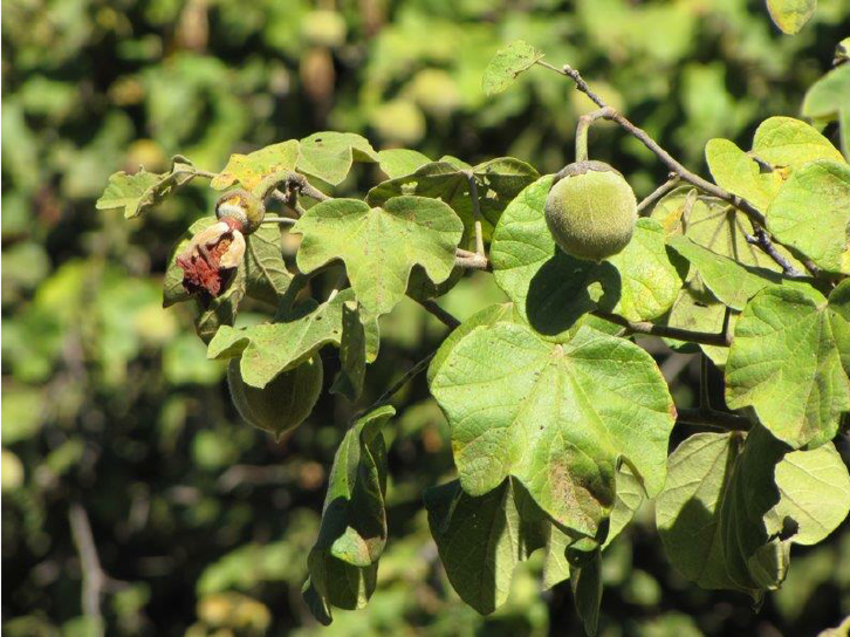Azanza garckeana

|
|
Thespesia garckeana Common Names: African chewing gum, snot apple, tree
hibiscus, Local Names: Scientific
Classification Kingdom: Plantae Clade: Tracheophytes Clade: Angiosperms Clade: Eudicots Clade: Rosids Order: Malvales Family: Malvaceae Genus: Thespesia Species: Thespesia garckeana Synonyms: Azanza
garckeana, Bupariti garckeana (F.Hoffm.) Rothm., Shantzia garckeana (F.Hoffm.)
Lewton, Colocynthis garckeana (F.Hoffm.) Kuntze, Abelmoschus garckeana
(F.Hoffm.) Kuntze, Gossypium garckeanum (F.Hoffm.) Kuntze, Hibiscus garckeanus
(F.Hoffm.) Kuntze, Malva garckeana (F.Hoffm.) Kuntze, Malvaviscus garckeanus
(F.Hoffm.) Kuntze, Sida garckeana (F.Hoffm.) Kuntze, Urena garckeana (F.Hoffm.)
Kuntze, Urenopsis garckeana (F.Hoffm.) Kuntze Morphological Description Thespesia garckeana,
commonly known as African chewing gum or Goron Tula, is a semi-deciduous, small
tree or shrub typically growing 3–10 m tall, occasionally reaching 12 m. It is
characterized by: · Stem: Young branches are densely pubescent with soft, shaggy
hairs, maturing to smooth, grey-brown bark (South African National Biodiversity
Institute [SANBI], 2024). · Leaves: Simple, alternate, broadly ovate, 3–5 lobed, 5–12 cm long,
with 5–7 basal veins and a longitudinal slit on the midrib; margins are entire
or slightly toothed, with a velvety texture (Maroyi, 2017). · Flowers: Large, solitary, axillary, up to 6 cm in diameter; petals
are crinkly, yellow, turning orange-red with age, each with a maroon patch at
the base; flowering occurs from October to March (SANBI, 2024). · Fruits: Round, woody capsules, 25–35 mm in diameter, 5-valved, green
when young, turning brown and dehiscent when mature; the edible, sweet, brown
flesh encases seeds with a mucilaginous texture, earning the name "snot
apple" (Mojeremane & Tshwenyane, 2004). · Seeds: Small, brown, embedded in the sticky pulp, containing
cyanogenic glycosides (Maroyi, 2017). The tree’s roundish
crown and tiered branching pattern enhance its ornamental value, making it a
favored species in urban landscaping (SANBI, 2024). Distribution and Habitat Thespesia garckeana is
widely distributed across tropical and subtropical Africa, recorded in
Botswana, Burundi, Democratic Republic of Congo, Kenya, Malawi, Mozambique,
Namibia, Nigeria, South Africa, South Sudan, Sudan, Tanzania, Zambia, and
Zimbabwe. It also occurs in Sri Lanka. The species thrives in: · Climatic conditions: Warm, frost-free regions with annual
rainfall of 500–1,500 mm and temperatures of 20–30°C (Mojeremane &
Tshwenyane, 2004). · Altitude: 1,000–2,000 m above sea level, occasionally up to 2,500 m in
East Africa (Maroyi, 2017). · Habitats: Open woodlands, wooded grasslands, thickets, riverine
vegetation, and rocky outcrops; frequently associated with termite mounds and
old fields due to fertile, well-drained soils (SANBI, 2024). · Soil types: Prefers sandy loam to clay soils with pH 5.5–7.0; tolerates
moderate drought but is intolerant of waterlogging (Mbuya et al., 1994). The species is
cultivated in Nigeria, Zimbabwe, and South Africa for its fruit and ornamental
qualities, and it is naturalized in some regions outside its native range
(SANBI, 2024). Ethnopharmacology Thespesia garckeana is
extensively used in African traditional medicine, with validated
pharmacological properties supporting its ethnomedicinal applications: · Female infertility: In Tula, Gombe State, Nigeria, a decoction
of ripe fruit is used to treat female infertility. Studies show that aqueous
fruit extract (AFETG) significantly increases serum estradiol (E2) levels and
enhances uterine endometrial thickness and ovarian tertiary follicle size,
supporting its use for infertility caused by reduced follicular size or
endometrial thinning (Omoniwa et al., 2023). Two phytoconstituents,
D-Melezitose and 1,3,4-trihydroxy-5-oxo cyclohexane-1-carboxylic acid, inhibit
5-alpha reductase 2 (SRD5α2), aiding E2 biosynthesis (Omoniwa et al., 2023). · Antibacterial activity: Root extracts yield (-)-gossypol and its
derivatives, exhibiting potent activity against vancomycin-resistant
Enterococcus faecium (IC50 1.71 μM) and E. faecalis, validating traditional use
for infections, including sexually transmitted diseases (Masila et al., 2015). · Respiratory ailments: Root infusions are used for chest pains
and coughs in Nigeria, Zimbabwe, and Kenya, likely due to flavonoids and
phenols with anti-inflammatory properties (Gelfland et al., 1985; Maroyi,
2017). · Menstrual disorders: Leaf and root decoctions are employed in
Nigeria and Kenya to regulate menstruation, possibly due to estrogenic
compounds like flavonoids (Mbuya et al., 1994). · Aphrodisiac and liver support: Fruit pulp is used as an aphrodisiac and
to treat liver ailments in Zimbabwe and South Africa, attributed to
antioxidants like ascorbic acid and carotenoids (Maroyi, 2017). Phytochemical analyses
confirm the presence of alkaloids, amino acids, ascorbic acid, carotenoids,
cyanogenic glycosides, flavonoids, lipids, phenols, saponins, and tannins,
contributing to its therapeutic effects (Maroyi, 2017). However, clinical
standardization and safety studies are needed (Omoniwa et al., 2023). ⚠ Toxicity Profile: While Thespesia garckeana is widely used,
caution is advised due to: Cyanogenic
glycosides: Seeds contain
cyanogenic glycosides, which can release cyanide upon metabolism, posing a risk
of toxicity if consumed in large quantities. Seeds should be avoided (Maroyi,
2017). Pregnant women and individuals with liver or kidney conditions should
consult healthcare providers before use (Maroyi, 2017). Additional Uses · Nutritional: The sweet, mucilaginous fruit pulp is eaten fresh, dried, or
processed into syrups, porridge, or relishes; rich in ascorbic acid and
carotenoids, it is a valuable food source in rural communities (Mojeremane
& Tshwenyane, 2004). · Ornamental: The tree’s symmetrical, tiered branching and vibrant flowers
make it a popular choice for urban landscaping in Nigeria and South Africa
(SANBI, 2024). · Material uses: Wood is used for small construction, tool handles, and
household items like spoons; bark fibers are used for rope-making in Zimbabwe
(Mbuya et al., 1994). · Cultural significance: In Hausa culture, the fruit is a
traditional snack, and the tree holds social value in community gatherings
(Maroyi, 2017). References
External Links More Pictures |
|
| Compounds of Azanza garckeana |
|
| References |